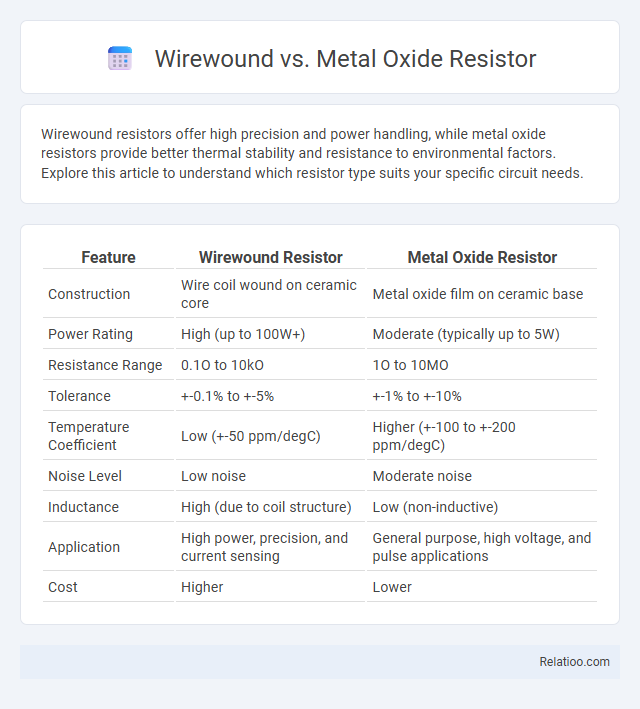Wirewound resistors offer high precision and power handling, while metal oxide resistors provide better thermal stability and resistance to environmental factors. Explore this article to understand which resistor type suits your specific circuit needs.
Table of Comparison
| Feature | Wirewound Resistor | Metal Oxide Resistor |
|---|---|---|
| Construction | Wire coil wound on ceramic core | Metal oxide film on ceramic base |
| Power Rating | High (up to 100W+) | Moderate (typically up to 5W) |
| Resistance Range | 0.1O to 10kO | 1O to 10MO |
| Tolerance | +-0.1% to +-5% | +-1% to +-10% |
| Temperature Coefficient | Low (+-50 ppm/degC) | Higher (+-100 to +-200 ppm/degC) |
| Noise Level | Low noise | Moderate noise |
| Inductance | High (due to coil structure) | Low (non-inductive) |
| Application | High power, precision, and current sensing | General purpose, high voltage, and pulse applications |
| Cost | Higher | Lower |
Introduction to Resistors: Wirewound vs Metal Oxide
Wirewound resistors feature a coil of wire, typically made from nichrome or similar alloys, offering high power dissipation and precision stability, ideal for high-current applications. Metal oxide resistors use a metal oxide film on a ceramic substrate, providing excellent heat resistance and superior performance in high-temperature environments. Both resistor types vary significantly in power rating, tolerance, thermal stability, and noise, making them suitable for distinct circuit requirements and protection needs.
Construction and Material Differences
Wirewound resistors consist of a metal wire, typically nickel-chromium or copper-nickel alloy, wound around a ceramic or fiberglass core, providing precise resistance and high power tolerance. Metal oxide resistors are constructed by depositing metal oxide films, such as tin oxide, onto a ceramic rod, offering excellent heat dissipation and stability under high voltage. Your choice depends on the specific application requirements, as wirewound resistors excel in high-power scenarios, while metal oxide resistors provide better stability and moisture resistance compared to standard carbon composition resistors.
Electrical Characteristics Comparison
Wirewound resistors offer high precision and stability with low noise, making them ideal for high-power applications, but they have higher inductance compared to Metal Oxide and carbon film resistors. Metal Oxide resistors provide excellent temperature stability, higher voltage ratings, and better surge resistance than general carbon film resistors, with moderate noise levels and lower inductance than wirewound types. Carbon film resistors generally exhibit higher noise and less stability but offer low inductance and a wide range of resistance values, suitable for general-purpose circuits where precision and power dissipation are less critical.
Power Rating and Heat Dissipation
Wirewound resistors offer high power ratings, often exceeding 10 watts, and excel in heat dissipation due to their coil construction on ceramic cores, making them suitable for high-power applications. Metal oxide resistors typically have moderate power ratings around 0.25 to 5 watts, with superior heat resistance compared to carbon film resistors, allowing better thermal stability under load. Your choice should consider that wirewound types handle higher power and dissipate heat more efficiently, while metal oxide resistors provide a balance between durability and moderate power handling.
Tolerance and Precision Levels
Wirewound resistors typically offer the highest precision and lowest tolerance, often as low as +-0.1%, making them ideal for applications requiring stable and accurate resistance values. Metal oxide resistors generally provide better tolerance than standard carbon film resistors, with tolerance levels commonly around +-1% to +-5%, ensuring improved temperature stability and reliability. Standard resistors, such as carbon film types, usually feature wider tolerance ranges of +-5% to +-20%, resulting in less precision compared to wirewound and metal oxide resistors.
Frequency Response and Noise Performance
Wirewound resistors offer excellent frequency response with minimal inductance and low noise, making them ideal for high-frequency applications where stability is crucial. Metal oxide resistors provide moderate frequency performance and exhibit higher noise levels than wirewound types but generally handle higher power and temperature. Standard carbon film resistors feature higher noise and less precise frequency response compared to wirewound and metal oxide resistors, limiting their use in sensitive frequency-dependent circuits.
Application Suitability: When to Use Each Type
Wirewound resistors are best suited for high power applications requiring precise resistance and reliability, such as in power supplies and audio equipment. Metal oxide resistors excel in high-temperature environments and provide better stability against overloads, making them ideal for industrial and automotive applications. Your choice between these resistors should depend on the application's power rating, temperature conditions, and need for accuracy.
Cost and Availability Factors
Wirewound resistors generally exhibit higher costs due to their precision and power-handling capabilities, making them less commonly stocked compared to metal oxide and standard carbon film resistors. Metal oxide resistors offer a balanced cost-to-performance ratio and are widely available, making them a preferred choice for applications requiring moderate power tolerance and stability. Standard carbon film resistors remain the most cost-effective and readily available option, suitable for general-purpose circuit designs with lower power and precision requirements.
Reliability and Durability Concerns
Wirewound resistors offer exceptional reliability and durability due to their robust construction with a metal wire coil, making them suitable for high-power and high-temperature applications. Metal oxide resistors provide improved heat resistance and longevity compared to carbon film resistors, but they may not match the mechanical strength and precision of wirewound types. Understanding these key durability differences helps you select the best resistor to ensure long-lasting performance in your electronic circuits.
Conclusion: Choosing the Right Resistor
Choosing the right resistor depends on the specific electrical requirements and application environment. Wirewound resistors offer high power handling and precision, making them ideal for high-current and high-temperature situations. Metal oxide resistors provide better stability and corrosion resistance for moderate power levels, while carbon film resistors suit low-power, cost-sensitive applications with less demanding precision.

Infographic: Wirewound vs Metal Oxide resistor
 relatioo.com
relatioo.com